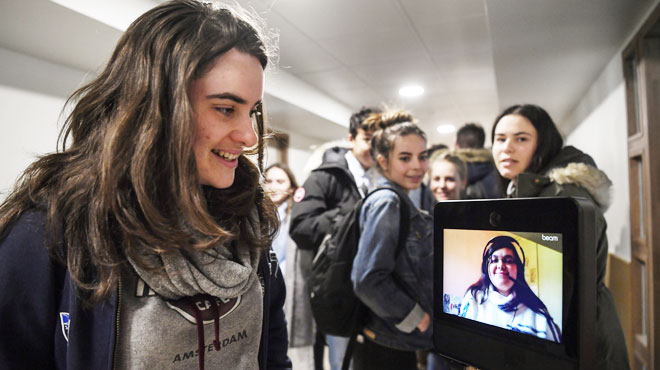A few weeks ago, the Ministry of National Education officially launched the TED-i program. More than 4,000 telepresence robots are currently deployed to ensure academic and social continuity with pupils and students who are sick for long periods. This massive plan is a world first, the result of a long-standing collaboration between Awabot and the educational community. Zoom on the major stages that have shaped tele-education in France.
Genesis of inclusive telepresence applied to education in the world
- Korea and Japan are pioneers in the use of telepresence robots in an educational context, mainly to enable teachers of foreign languages who are far from their classroom to carry out their teaching from a distance.
- North America then took over the uses of telepresence robots in the United States and Canada.
- In France, the first major project is the «Robot Lycéen» project launched in 2014 in the Auvergne-Rhône-Alpes region. Other experimentations followed and more particularly in the department of Landes.
2014.
Robot Lycéen in Auvergne Rhône Alpes Region: from experimentation to deployment
The Robot Lycéen project was positioned in 2013 as the first experimenter of this type of device in an educational context, in France and in Europe. This project had 2 phases.
- 2014 – 2016: Robotic experimentation for students far from school
The Rhône-Alpes Region has proposed to experiment with a telepresence robot in order to report on the possibilities of use among high school students temporarily removed from the school environment for health reasons.
This experiment involved three pilot schools and two medical-school structures: no less than 14 students benefited from the Robot Lycéen, connected during sessions ranging from 5 to 80 hours of use, over periods of one week to three months. The reasons for use were mainly related to convalescence following illness or accident.
First, Awabot deploys the QB telepresence solution, from Anybots. Then, the Beam® robot, designed at this period by the American company Suitable Technologies, was used.
- 2018 – 2022: deployment of 60 BEAM telepresence robots by the Auvergne Rhône-Alpes region
This large-scale deployment follows the success of the preliminary experimentation, whose benefits mentioned were:
- the continuity of learning, which does not stop at the simple fact of avoiding the student to interrupt his course but goes further, allowing him not to fall behind and not to be forced to repeat his class.
- maintaining contact with classmates and teachers, a real incentive for the student to return to class more quickly.
- the expression of solidarity between the students and also a positive impact on the climate of the class and on the collective awareness related to the state of health of a member of the class.
2017.
Telepresence devices for general school Inclusion
Following the expansion of the Robot Lycéen, the mobile telepresence devices Beam® for pupils and students prevented from entered higher education institutions:
- Université de Bourgogne
- Université de Pau et des Pays de l’Adour
- Université Bretagne Sud
- Université de Lyon
- Université de Franche Comté
- Université de Montpellier
- Sorbonne Université
The handicapped departments of the French Business Schools are also equipped:
- Ecole Centrale de Lyon
- HEC Paris
- Sciences Po
- EM Lyon
- Ecole de Management de Normandie
- Université Polytechnique Hauts-de-France
- Université Paris Est Créteil
- Université de Cergy Pontoise
- Université de Poitiers
- Université de Toulon
- Université de Bordeaux
- Université de Valenciennes…
Some French departments have also deployed the Beam® robot in secondary schools:
- Department of Yvelines
- Hauts-de-Seine Department
2020.
The tele-education robot, now a standard tool for school inclusion in France thanks to the TED-i program launched by the Ministry of Education
Since 2020, the French Ministry of Education, sets up a robotic telepresence system called TED-i is available to educational institutions from the end of primary school to university for children, young adolescents and adults who are seriously ill and for long periods of time.
The major challenge of the scheme is to enable pupils prevented by serious and long-term somatic diseases, whether in hospital or nursing homes, at home, or in a place of convalescence, continue to have access to their school and social life of the latter.
Regarding the number of students who will need to keep the link with their studies, more than 1750 Beam by GoBe Robots® are currently being manufactured and deployed by Awabot, enabling pupils and students to be present in class, from the hospital or their home, through the device, which must enable them to interact fully with their peers and teachers.
Do you have a telepresence project for inclusion?
We remain at your disposal to build it together.




